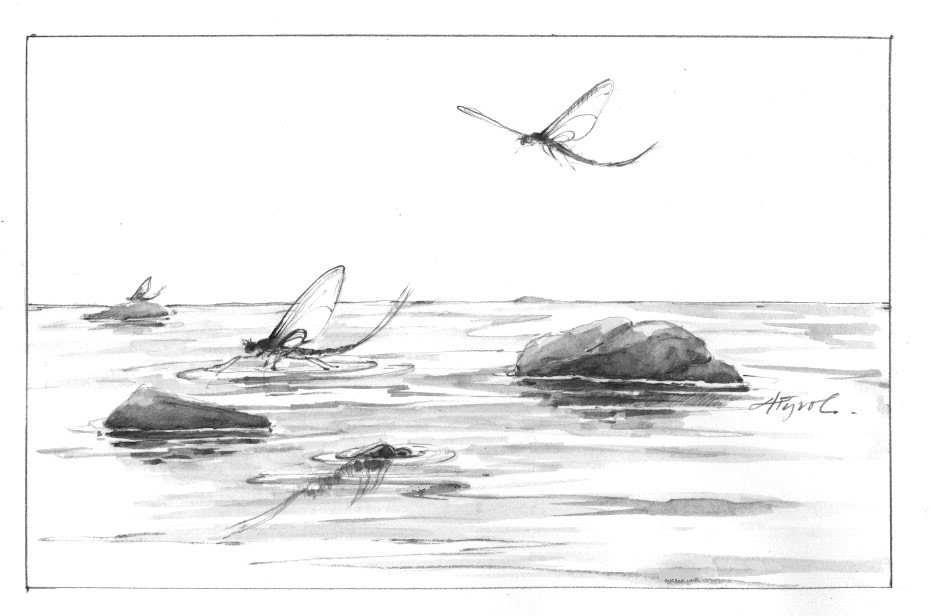
In the world of insects, life is usually short. House flies, for instance, go from egg to adult 10 to 12 times a year. There are no insects named Methuselah, and the name given to mayflies – Ephemeroptera – singles them out for their brevity. While ephemeral has generally come to mean “of short duration,” its literal meaning is “lasting for one day only.” With their one day of life as winged adults, mayflies are truly here today and gone tomorrow. But that doesn’t tell the whole story, because the one day a mayfly spends as a flying, mating adult is preceded by a full year in its previous two stages, as an egg and as a larva.
If it weren’t for flyfishermen, there would be very few people who paid attention to mayflies despite how delicately beautiful many of them are. Mayflies are one of the three main aquatic insects – the others are caddisflies and stoneflies – that are a staple for trout. With their upright wings and segmented abdomens, mayflies are the insects most often imitated by those who tie artificial flies. Mayflies also have been given some of the most colorful names: Quill Gordon, Light Cahill, Blue-Winged Olive, Leadwing Coachman, Pale Evening Dun.
At this time of year, there is one particular mayfly whose presence in the air gets fishermen to patch their waders. It is known as the Hendrickson, Ephemerella subvaria, and it makes its metamorphosis into adulthood just at the time that trout are beginning to feed aggressively and flyfishermen are desperate for any excuse to stand in a river.
The reason the fishermen are excited is that, like many aquatic insects, Hendricksons synchronize their emergence such that every afternoon for the next few weeks, rivers will be full of Hendrickson larvae (known to fishermen as nymphs) dislodging themselves from the rocks on the river bottom and drifting to the surface. This mob-scene emergence is triggered when the water temperature reaches 52-55 degrees Fahrenheit and stays there for a few days.
En route to the river’s surface, each larva sheds its exoskeleton so that when it breaks through the surface film, its wings are free. It’s been transformed from its larval stage to that of a subimago (a dun to a fisherman), and it floats downstream shaking its wings before it manages to lift itself off the surface. That is, unless it has been eaten. Trout feast on the Hendrickson as it drifts to the surface and as it struggles in the surface film. Once it breaks free of the surface, it has other predators, and its deliberate flight might be intercepted by one of the swallows that invariably know when the air is full of these large mayflies. If still unscathed, the Hendrickson’s destination is a streamside tree or shrub, where it will settle in for the evening, its four tan wings held upright and together like a butterfly at rest.
The next morning, it will do what no other insect does – it will molt a second time, going from a subimago to an imago, a full adult or a spinner. The life stages of most insects proceed from egg to larva to pupa to adult. Only the mayfly skips the pupal stage and has two winged phases. During the second molt, the wings change from the cloudy tan of the emergence to translucent.
The males and females are distinct: males are redder and have larger eyes; the females are grayish and noticeably larger. Most mayflies range in size from 1/8 inch to 5/8 inches (a few species exceed an inch long). Hendricksons have a body as long as a half-inch, extended by three tails that, on the adults, are as long as the body.
In the afternoon, the males will begin to swarm over the water, rising and falling. Again, they’ll be eaten by swallows and other flycatchers. One by one, the females join the males. Mating takes place in flight – if you only have one day as an adult, you better make the most of it – and once it’s accomplished, the females fly over the water and seem to hop on its surface, depositing their eggs. Their missions accomplished, they fall to the surface and expire.
The eggs, meanwhile, drift to the bottom and lodge in the gravel to incubate, starting the year-long cycle once again. After a couple of weeks, they will hatch into nymphs, and they’ll spend the summer, fall, and winter grazing on plants, algae, and organic detritus. They’re chunky, have two antennae, six legs, and three tails. The nymphs are more comfortable crawling than swimming, so they prefer water with a fairly gentle current – in current that’s too swift, they’ll be swept downstream, perhaps helping to fill a trout’s belly.

